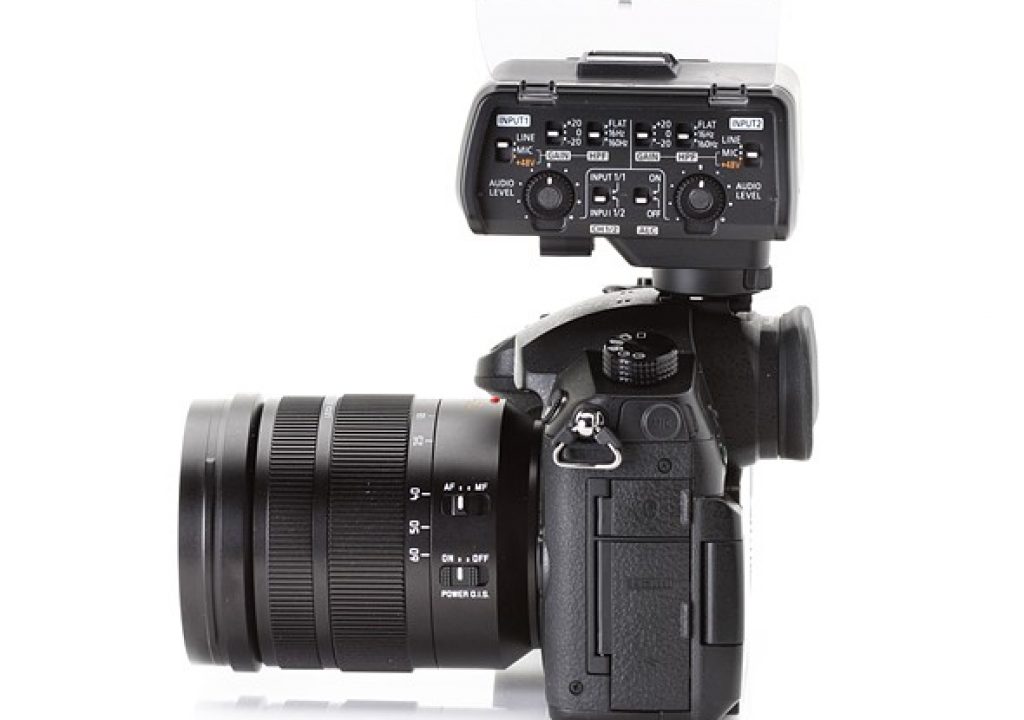
Back in January 2017, I first wrote about Panasonic’s new GH5 and its DMW-XLR1 XLR audio interface (link ahead). At that time, I covered the DMW-XLR1’s specs and features, many of which were still quite obscure: Panasonic neglected to publish the total available gain, which is especially important with dynamic microphones. Despite no response so far from Panasonic to my inquiry, fortunately Curtis Judd has now done a thorough test and video review. Ahead you’ll see and hear his video review, together with my comments.

Link to my prior GH5 articles
- Panasonic Lumix GH5 goes 4:2:2/10-bit/24-bit internal recording and more
- How to pick optics for the new GH5 camera/camcorder

Curtis Judd’s complete review on the DMW-XLR1 XLR audio interface, and my comments
Kudos to Curtis for his excellent review!
I have the following comments to add, for those who desire to use (a) dynamic microphone(s) with the GH5 (Amazon link, B&H link):
- If you don’t already own a portable audio mixer, Beachtek or JuicedLink to pre-boost the dynamic microphone’s lower level (or otherwise prefer the simplicity of not having to carry, power and adjust another device for certain shoots), you can consider using a FetHead (Amazon link, B&H link), which is a pre-preamplifier inside an XLR barrel connector that boosts the output of the dynamic mic about 27 dB to satisfy a weaker preamp in a device like the DMW-XLR1. As covered in prior articles, the FetHead is actually powered via phantom power from the host device, so no extra power supply or power cable is required. As you probably saw and heard in Curtis’s video review above, the DMW-XLR1 XLR audio interface fortunately offers phantom power.
- If you do own a portable audio mixer (or Beachtek/JuiceLink) and have no objection to carrying, powering and adjusting it, you may be questioning why you should spend almost US$400 on the DMW-XLR1, considering that you could connect the output of the mixer (or Beachtek/JuiceLink) to the GH5’s 3.5 mm input. Here are 3 justifications:
- The XLR input offers a more secure physical connection.
- The balanced XLR input offers a much higher resistance to electromagnetic or RF (radio frequency) interference.
- 24-bit recording. Panasonic has published that the DMW-XLR1 offers 24-bit recording, but so far, neither Panasonic nor Curtis has said anything about the GH5 being able to record 24-bit audio without the DMW-XLR1. The only portions of the GH5 operator’s manual that make reference to 24-bit audio recording are when it makes direct reference to the optional DMW-XLR1, so it appears that the DMW-XLR1 is a requirement for 24-bit audio recording in the GH5. See my 2015 article: Understanding 24-bit vs 16-bit audio production & distribution to appreciate why it’s better to record raw audio at 24-bit, even though you may not distribute 24-bit audio.
Upcoming articles, reviews, radio shows, books and seminars/webinars
Stand by for upcoming articles, reviews, and books. Sign up to my free mailing list by clicking here. Most of my current books are at books.AllanTepper.com, and my personal website is AllanTepper.com.
Si deseas suscribirte a mi lista en castellano, visita aquí. Si prefieres, puedes suscribirte a ambas listas (castellano e inglés).
Listen to his CapicúaFM show at CapicúaFM.com in iTunes or Stitcher.
FTC disclosure
No manufacturer is specifically paying Allan Tépper or TecnoTur LLC to write this article or the mentioned books. Some of the other manufacturers listed above have contracted Tépper and/or TecnoTur LLC to carry out consulting and/or translations/localizations/transcreations. Many of the manufacturers listed above have sent Allan Tépper review units. So far, none of the manufacturers listed above is/are sponsors of the TecnoTur programs, although they are welcome to do so, and some are, may be (or may have been) sponsors of ProVideo Coalition magazine. Some links to third parties listed in this article and/or on this web page may indirectly benefit TecnoTur LLC via affiliate programs. Allan Tépper’s opinions are his own.
Copyright and use of this article
The articles contained in the TecnoTur channel in ProVideo Coalition magazine are copyright Allan Tépper/TecnoTur LLC, except where otherwise attributed. Unauthorized use is prohibited without prior approval, except for short quotes which link back to this page, which are encouraged!


